8 Churches With Unique Architecture Designs In The World
When people think of churches, the first thing that comes to their minds is some old, ancient buildings with hundred-year-old architecture designs that have a history of their own. But there are also churches with unusual architecture, striking design features, which astonish tourists from around the world.
1. Las Lajas Sanctuary, Ipiales, Colombia
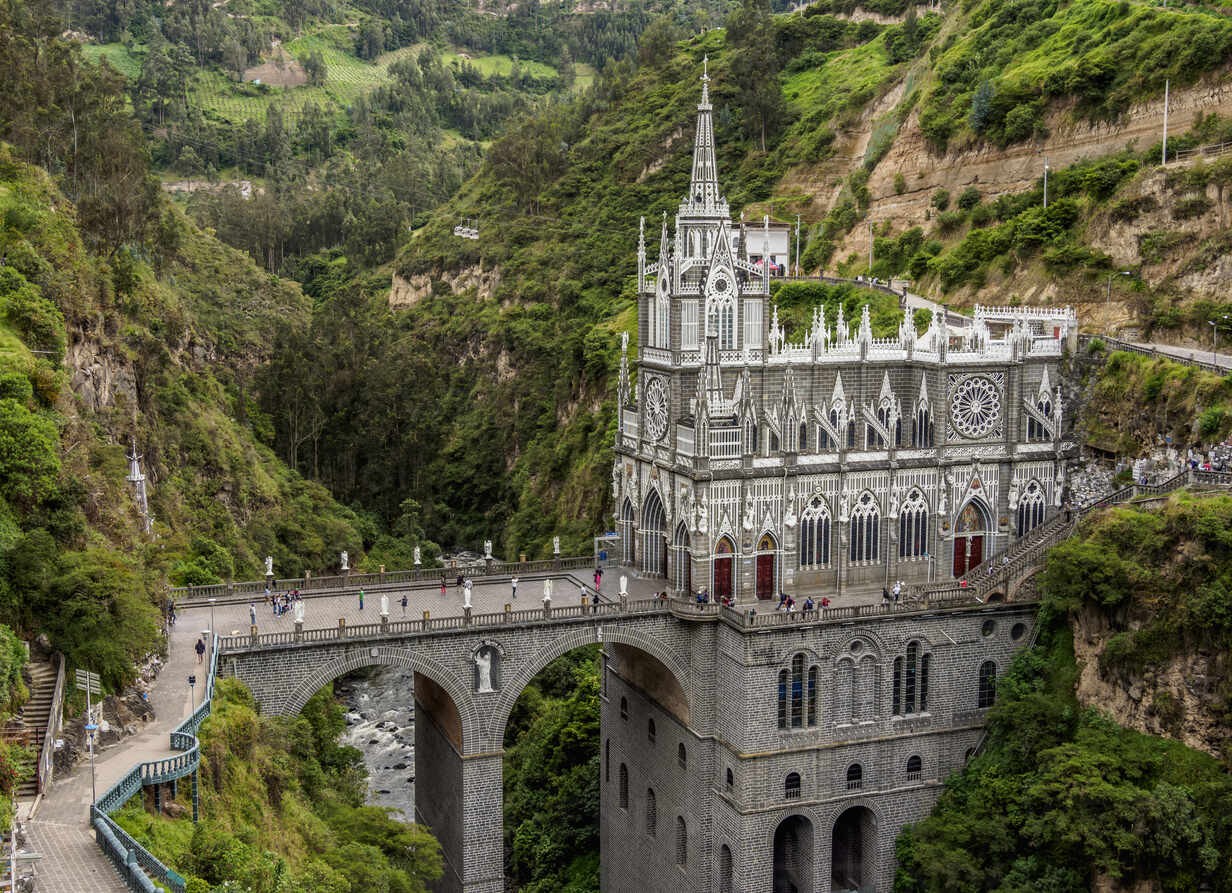 |
| Photo: Westend61 |
Las Lajas Sanctuary (Santuario de Las Lajas) is arguably considered the most beautiful church in Colombia. It’s also considered by many to be one of the most beautiful churches in the world. And The Telegraph even named Las Lajas Sanctuary the most beautiful church in the world in 2015.
Las Lajas Sanctuary is a minor basilica church located in Ipiales, which is located in the southern Colombian Department of Nariño. The church sits on a 130 feet tall bridge over the Guáitara river. In addition, it’s located less than seven miles from the Ecuadorian border.
Las Lajas Sanctuary is a Gothic Revival-style church built inside a canyon of the Guáitara river. So, it’s often been called a jewel of engineering. This Roman Catholic church is dedicated to the veneration of Our Lady of Las Lajas Ipiales.
The Las Lajas Sanctuary is famous for its stunning architecture and a series of legends involving the appearance of the Holy Virgin and a mysterious mural of which nobody knows the origins.
2. Sedlec Ossuary, Kutná Hora, Czech Republic
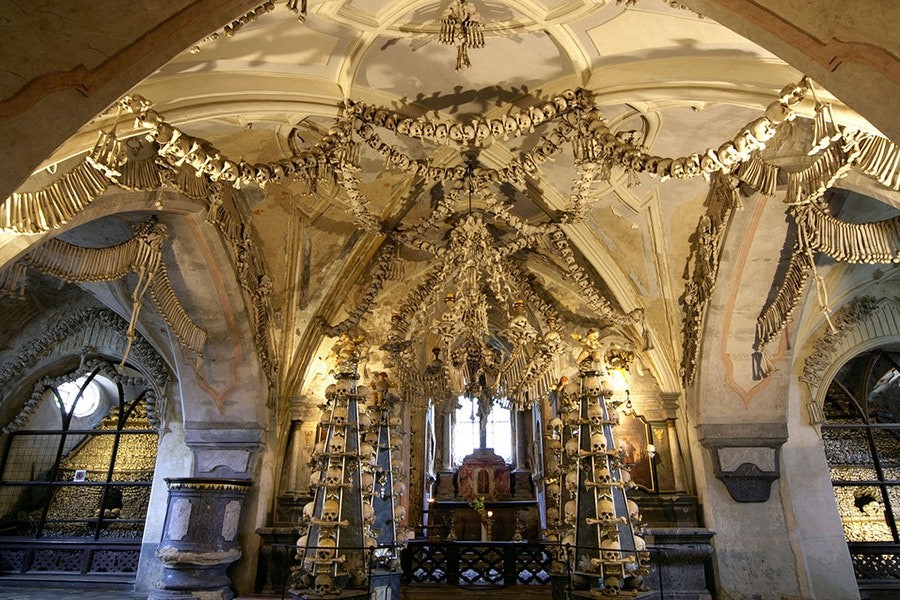 |
| © m c photography / Alamy |
Known to most as “the Bone Church,” it displays some of the world’s more macabre art. In addition to a splendid bone chandelier composed of almost every bone in a human body, the ossuary displays two large bone chalices, four baroque bone candelabras, six enormous bone pyramids, two bone monstrances (a vessel used to display the Eucharistic host), a family crest in (you guessed it) bone, and skull candle holders. Festively looping chains of bone are hung throughout like crepe paper at a birthday party.
Sedlec Ossuary has a long history, beginning in the 13th century when the Abbot of the Sedlec Monastery (Abbot Henry) brought a handful of the earth back from a journey to the Grave of the Lord in Jerusalem. He scattered this “holy soil” across the Sedlec cemetery, securing its place as one of the most desired burial sites for people all over Bohemia and the surrounding countries. Everyone wanted to be buried in that handful of the Holy Land and more than 30,000 were. But it wasn’t long before there simply wasn’t enough room for everyone to rest in peace, and the bodies were moved to a crypt to make room for the newly dead, according to Atlas Obscura.
3. La Sagrada Familia, Barcelona, Spain
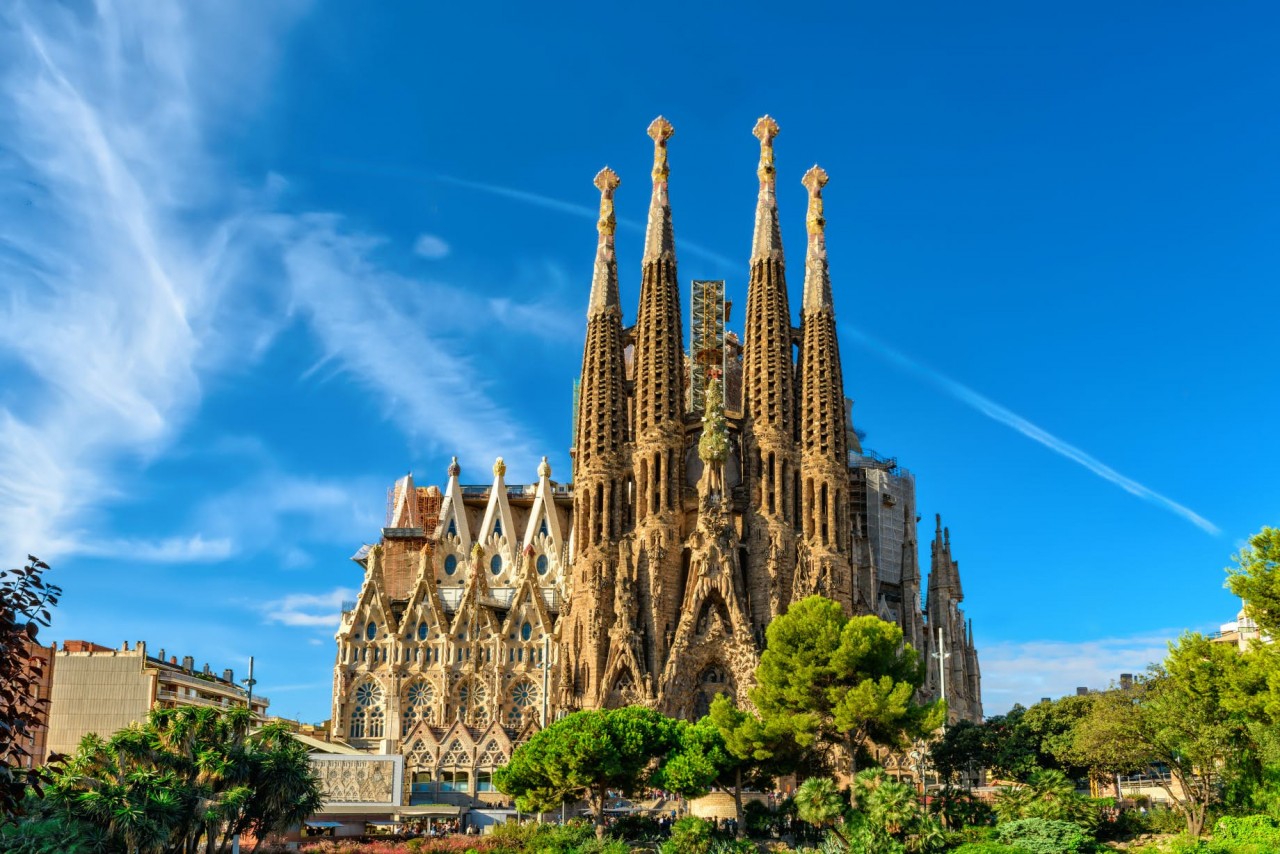 |
| Photo: Lonely Planet |
The Temple Expiatori de la Sagrada Família (Expiatory Temple of the Holy Family) is considered to be the symbol of Barcelona by many residents, and the one place you shouldn’t miss when you visit the Catalan capital.
Initially intended to be a simple Roman Catholic church dedicated to Jesus, Mary, and Joseph, the church ultimately became the most prominent example of Catalan Modernism. Pope Benedict XVI declared it a basilica in 2010.
Dreamed up by Catalan architect Antoni Gaudí, the basilica exemplifies Gaudí’s philosophy that nature is the work of God. Gaudí sought to combine Christian speech and biblical allegories with complex natural symbols like organic, geometric shapes which are prominent in every column, pinnacle, and stained glass window of the basilica.
The end result is an astounding architectural masterpiece which, despite being unfinished and under construction for nearly 140 years, has become one of the most visited monuments in Spain, receiving 4.7 million visitors in 2019, according to Lonely Planet.
4. Tan Dinh Church, Vietnam
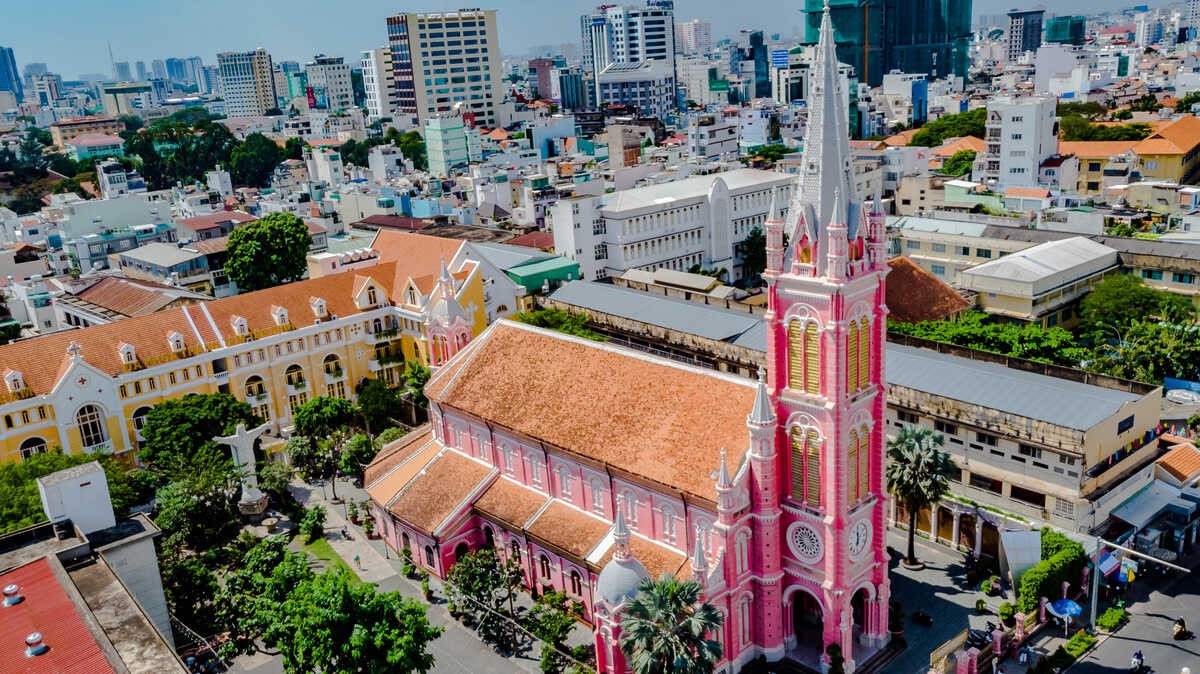 |
| Photo: Shutterstock |
Tan Dinh Church Saigon is a Romanian-style church in Ho Chi Minh City, where you can see intricate Gothic and Renaissance elements that have managed to survive Vietnam’s turbulent periods. Built in 1876 and spanning 60 metres in height, it’s widely regarded as the second biggest church in Ho Chi Minh City, after Notre Dame Cathedral. Nearby the gate is two massive bell towers, while the bright pink church is fitted with three beautifully-decorated Italian marble altars.
In 1877, Father Donatien Éveillard invited the Sisters of Saint-Paul de Chartres to set up an orphanage and boarding school beside the church, which had housed over 300 youths in the span of three years. A publishing house is then added to the cathedral grounds, where disadvantaged children were educated for the publishing trade. To honor his contributions to the local community, he was buried beneath the nave of Tan Dinh Church following his death in 1883.
Located on Hai Ba Trung Street in District 3, Tan Dinh Church Saigon is a 10-minute taxi ride from District 1. Whilst you’re exploring the area, we highly recommend stopping by at the nearby Tan Dinh Market to browse through an extensive collection of fabric, bags, clothing, and produce, as well as snack on inexpensive street food. The church is also close to Le Van Tam Park, where you can find plenty of carnival rides for children, according to the Vietnam Guide.
5. Cathedral of Brasilia, Cathedral of Brasilia
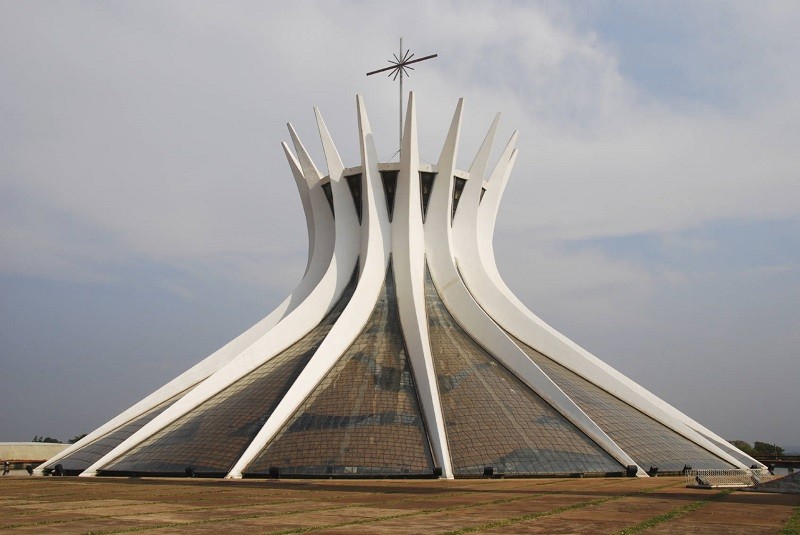 |
| Photo: Designing Buildings Wiki |
The Cathedral of Brasília is the Roman Catholic cathedral serving Brasília, Brazil, and serves as the seat of the Archdiocese of Brasília. It was designed by Brazilian architect Oscar Niemeyer and projected by Brazilian structural engineer Joaquim Cardozo, and was completed and dedicated on May 31, 1970. The cathedral is a hyperboloid structure constructed from 16 concrete columns, weighing 90 tons each.
In the square access to the cathedral, are four 3-meter (9.8 ft) tall bronze sculptures representing the four Evangelists created by sculptor Dante Croce in 1968. A 20-meter (66 ft) tall bell tower containing four large bells donated by Spanish residents of Brazil and cast in Miranda de Ebro also stands outside the cathedral, to the right as visitors face the entrance. At the entrance of the cathedral is a pillar with passages from the life of Mary, mother of Jesus, painted by Athos.
A 12-meter (39 ft) wide, 40-centimeter (16 in) deep reflecting pool surrounds the cathedral roof, helping to cool the cathedral. Visitors pass under this pool when entering the cathedral.
The cathedral is capable of holding up to 4,000 people. The baptistery is to the left of the entrance and can be entered either from the cathedral or via a spiral staircase from the entrance plaza. The walls of the oval baptistery are covered in ceramic tiles painted in 1977 by Athos Bulcão. Offices for the Archdiocese of Brasilia were completed in 2007 next to the cathedral. The 3,000-square-metre (32,000 sq ft) building connects directly to the cathedral underground.
6. Church of Hallgrímur, Reykjavik, Iceland
 |
| Photo: Shutterstock |
As an astounding landmark in the capital city of Iceland, Hallgrimskirkja Church is the highest building in downtown Reykjavik, dominating the skyline of the northernmost capital of the world. It stands out among the cute, colorful two-floored houses, and for which it’s one of the most photogenic spots in the entire country. As a destination like no other, we are going to go over everything you need to know about visiting Hallgrimskirkja church and its vicinity.
The Lutheran church was named after the 17th-century Icelandic poet and clergyman Hallgrímur Pétursson. His most renowned work is the Passion Hymns, which writes in Icelandic as “Passíusálmar.” Unlike many Icelandic words that sound like tongue twisters, the church’s name is relatively easy to pronounce. The most common mistakes that foreigners make is to pronounce the two “l”s since in Icelandic the double “l”s is pronounced like “t.”
In 1929, the Parish of Reykjavik initiated a national competition looking for an ideal blueprint for a new church in downtown Reykjavik - a church that should seat 1200 people, that has a high tower that additionally serves as a radio mast for the national radio service that’s soon to be founded. However, until 1937, there was no winner in the competition. So, the Parish passed the task to the State Architect of Iceland, Guðjón Samúelsson, who has designed multiple important structures in the city.
But the construction of Hallgrimskirkja Church was not smooth sailing. The architect himself passed away in 1950 due to a disease, leaving the design of the church unfinished. In the following years, other architects had to try their best to work out a plan for continuing the vision of Samuelsson. The task of completing the design fell on architects Hörður Bjarnason and Garðar Halldórsson. The construction started in 1945, after more than 40 years and going through all the criticisms and debates, Hallgrimskirkja Church finally consecrated on 26 October 1986.
7. Temppeliaukio Church, Helsinki, Finland
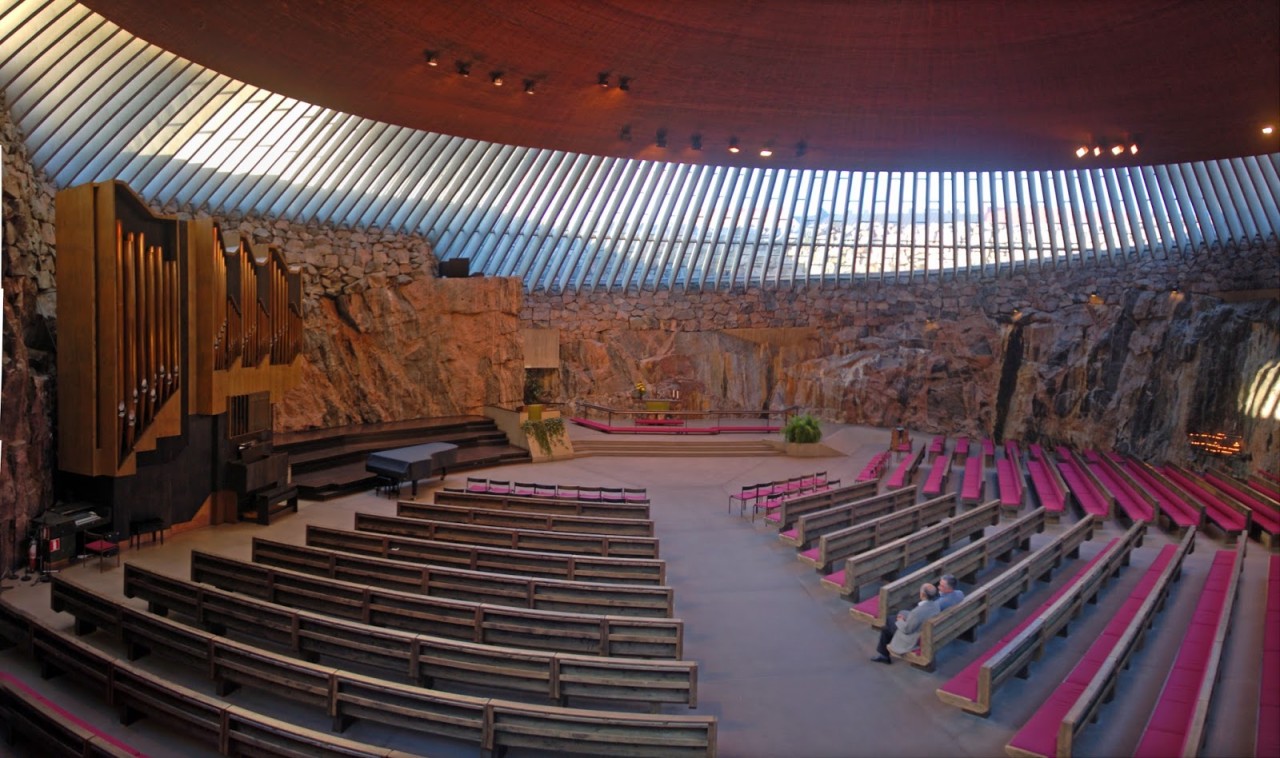 |
| Photo: Ralf Roletschek |
Completed in 1969, Temppeliaukio Church is carved right from the bedrock in the center of Helsinki.
The underground house of worship, called Temppeliaukion kirkko in Finnish, was designed by architect brothers Timo and Tuomo Suomalainen in the charmingly named Töölö neighborhood. On all sides of the circular church are roughly hewn stone, where sometimes water still seeps in to create miniature waterfalls. A dome coated with copper covers the rock church, with a skylight open in a belt below it to make the dome appear to hover. Even further below the church is a Cold War-era air-raid shelter, which now serves as parking.
Despite its cave-like appearance, Temppeliaukio Church actually has marvelous acoustics, where the sound beautifully bounces from the craggy stone, according to Atlas Obscura.
8. Cadet Chapel, U.S. Air Force Academy, Colorado
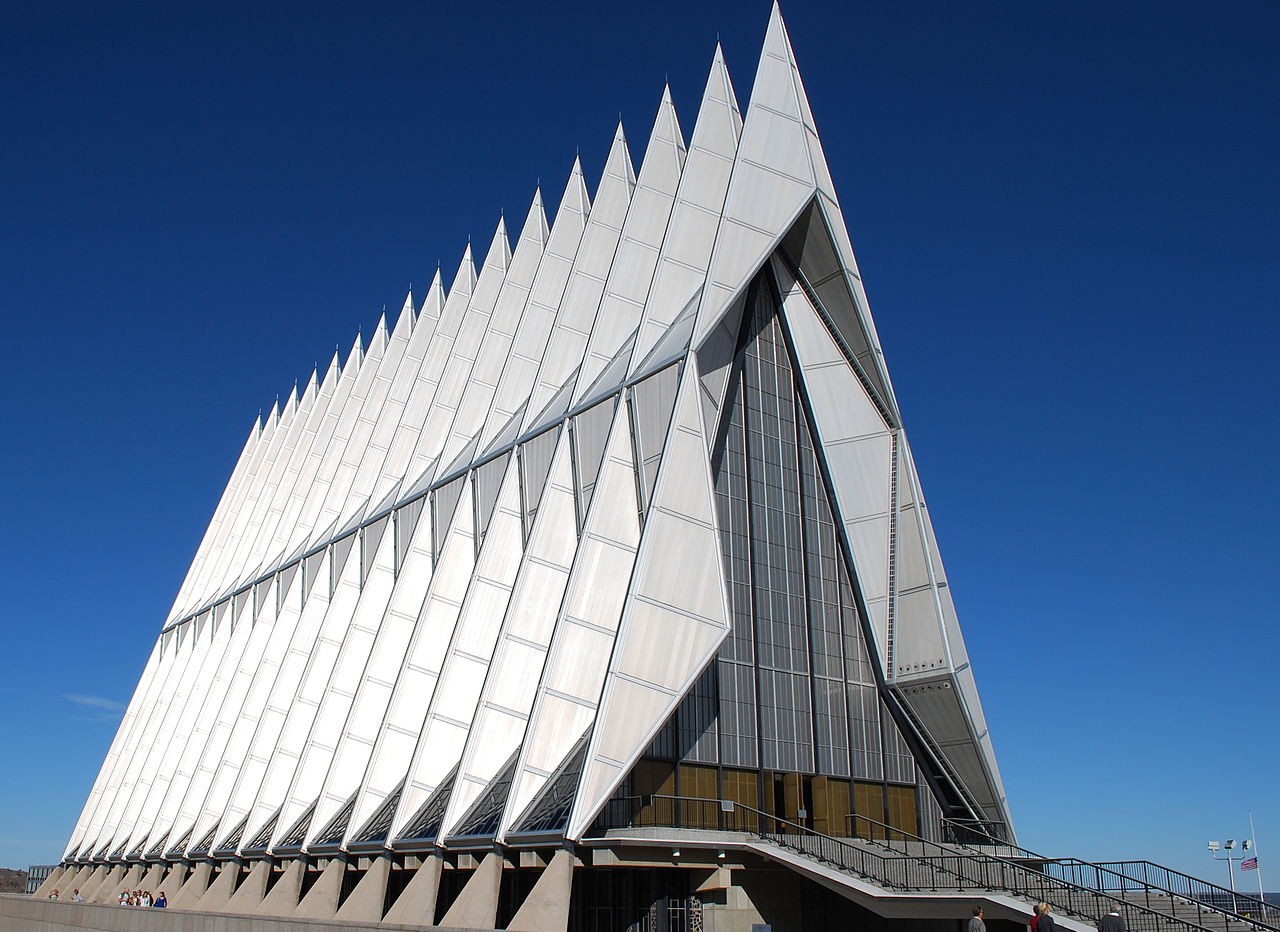 |
| Photo: Wikimedia Commons |
The United States Air Force Academy Cadet Chapel, completed in 1962, is the distinguishing feature of the Cadet Area at the United States Air Force Academy north of Colorado Springs. It was designed by Walter Netsch of Skidmore, Owings, and Merrill of Chicago. Construction was accomplished by Robert E. McKee, Inc., of Santa Fe, New Mexico. Originally controversial in its design, Cadet Chapel has become a classic and highly regarded example of modernist architecture. Cadet Chapel was awarded the American Institute of Architects' National Twenty-five Year Award in 1996 and, as part of the Cadet Area, was named a U.S. National Historic Landmark in 2004.
The most striking aspect of the Chapel is its row of seventeen spires. The original design called for twenty-one spires, but this number was reduced due to budget issues. The structure is a tubular steel frame of 100 identical tetrahedrons, each 75 feet (23 m) long, weighing five tons, and enclosed with aluminum panels. The panels were fabricated in Missouri and shipped by rail to the site. The tetrahedrons are spaced a foot apart, creating gaps in the framework that are filled with 1-inch-thick (25 mm) colored glass. The tetrahedrons comprising the spires are filled by triangular aluminum panels, while the tetrahedrons between the spires are filled with a mosaic of colored glass in aluminum frame.
Cadet Chapel itself is 150 feet (46 m) high, 280 feet (85 m) long, and 84 feet (26 m) wide. The front façade, on the south, has a wide granite stairway with steel railings capped by aluminum handrails leading up one story to a landing. At the landing is a band of gold anodized aluminum doors, flanked by gold anodized aluminum panels, designed and detailed to match the doors.
The shell of the chapel and surrounding grounds cost $3.5 million to build. Various furnishings, pipe organs, liturgical fittings, and adornments of the chapel were presented as gifts from various individuals and organizations. In 1959, a designated Easter offering was also taken at Air Force bases around the world to help complete the interior.
 | The Extraordinary Story of Beautiful Fort Bragg’s Glass Beach, California California has many wonderful and unique spots to discover, and one of them is Glass Beach near Fort Bragg, an amazing site with thousands of ... |
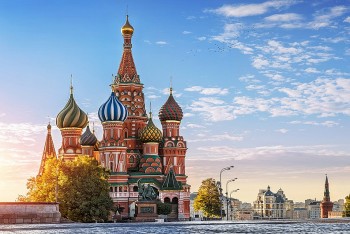 | 6 Most Stunning and Beautiful Churches In The World From Saint Basil's Cathedral to Duomo di Milano, here are the 6 most stunning and beautiful churches with outstanding architecture around the world that you ... |
 | Top 7 Tallest And Biggest Statues In The World Building statues is hard work, and some of the biggest and tallest statues in the world nowadays are considered masterpieces for their incredible architecture and ... |
Recommended
 World
World
India-EU trade agreement expected to be promoted in the future
 World
World
German Chancellor Merz begins his first state visit to India
 World
World
Vietnamese Lunar New Year Food Fair 2026 Showcases Cultural Identity in Malaysia
 World
World
India named President of BRICS+ for the 2026 term
Popular article
 World
World
India strengthens defense and security ties with Central Asia
 World
World
India–Brazil–South Africa (IBSA) Dialogue Forum: An Assessment – Analysis
 World
World
India’s package for exporters signals confidence in Southeast Asia markets
 World
World







